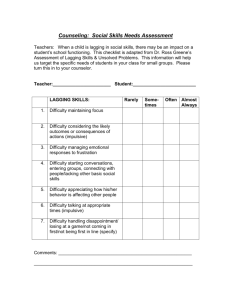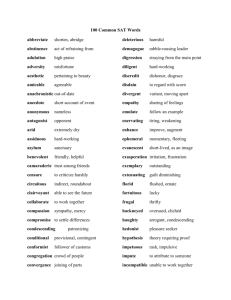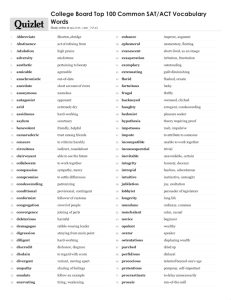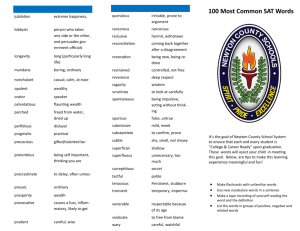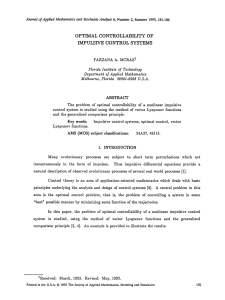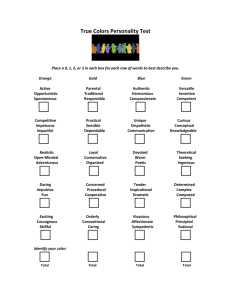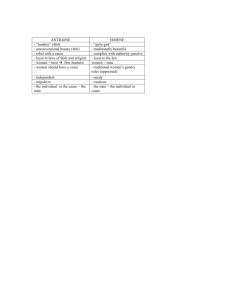Multiple pathways to impulsive choice Kimberly Kirkpatrick Kansas State University
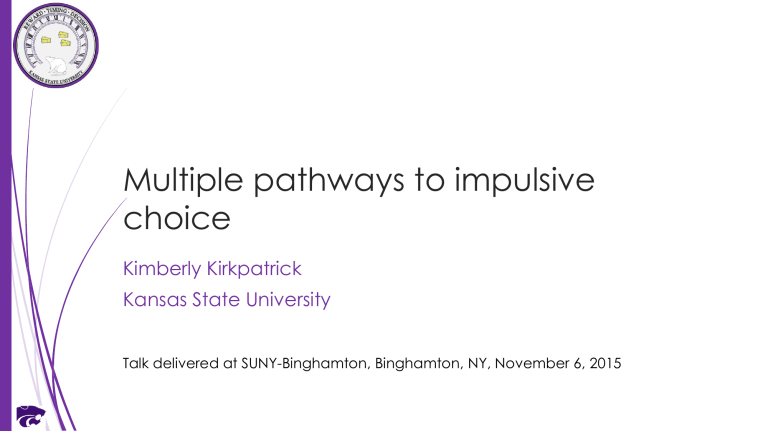
Multiple pathways to impulsive choice
Kimberly Kirkpatrick
Kansas State University
Talk delivered at SUNY-Binghamton, Binghamton, NY, November 6, 2015
The Marshmallow Test
Smaller-Sooner (SS) “Impulsive”
“Impulsive choice is a bias to choose SS, when doing so is disadvantageous”
Larger-Later (LL) “Self-controlled”
= higher SAT scores better social skills better coping skills
Mischel, Shoda & Rodriguez (1989)
Individual differences in impulsive choice
Individual differences in impulsive choice are related to:
Substance abuse
(e.g., Bickel & Marsch, 2001; Carroll et al., 2009; deWit,
2008)
Pathological gambling
(e.g., Alessi & Petry, 2003; MacKillop et al.,
2011; Reynolds et al., 2006)
Obesity
(e.g., Davis et al., 2010)
ADHD
(e. g., Barkley et al., 2001; Solanto et al., 2001; Sonuga-Barke, 2002 )
Impulsive choice is a trans-disease process
(Bickel &
Mueller, 2009)
Impulsive choice: Method
Offer rats choices between smaller-sooner
(SS) and larger-later (LL) rewards (based on
Green & Estle, 2003)
SS = 1 pellet in 10 s
LL = 2 pellets in 30 s
ITI = 60 s
Can manipulate delay to and/or magnitude of reward
Choices of SS indicate impulsive choice in most cases as they earn fewer rewards
?
“Impulsive”
Smaller-Sooner (SS)
Larger-Later (LL)
“Self-controlled”
Bias versus sensitivity
Mean/AUC and Slope/k have a non-linear relationship (Mitchell et al, 2015)
Bias
Mean (or AUC)
Sensitivity
Slope (k)
Individual differences
In humans, impulsive choice appears to be a stable trait variable
Are the most impulsive individuals at Time 1 also the relatively most impulsive individuals at Time 2?
Test-retest correlations for humans in the .6-.7 range over periods from 1 week to 1 year; comparable to other trait variables
(e.g., Jimura et al., 2011; Johnson, Bickel, & Baker, 2007; Kirby, 2009;
Matusiewicz et al., 2013; Ohmura et al., 2006)
Delay
Test Impulsive Choice Re-test Impulsive Choice
Individual differences in rats
Broad spectrum of individual differences
(see also Galtress, Garcia, &
Kirkpatrick, 2012; Garcia &
Kirkpatrick 2013)
Significant test-retest reliability at 1-month and 5-month delays
(Peterson, Hill & Kirkpatrick, 2015) r = .64
r = .76
Impulsive
Peterson et al. (2015)
Sources of individual differences
Given that individual differences are stable traits, what are the sources of the individual differences?
Approach 1: Distal factors
Genetic differences – may contribute to the formation of the impulsive phenotype
Rearing environment – may contribute to the expression of the impulsive phenotype
Approach 2: Proximal factors
Timing Processes – should be critical for processing the delay to reward
Reward Processes – should be critical for processing the magnitude of reward
Strain differences: SHR vs. WKY
Increased activity, impulsivity, and deficits in sustained attention, and alterations in the dopaminergic system
(Davids, Zhang, Tarazi, &
Baldessarini, 2003; Sagvolden, 2000)
However, there are inconsistencies in the literature in reporting the cognitive and behavioral differences in the SHR strain
(Adriani,
Caprioli, Granstrem, Carli, & Laviola, 2003; Orduña, Garcia, &
Hong, 2010)
Strain differences: LEW vs. Wistar/F344
Reduced reward system dopamine and serotonin function
(Huskinson et al., 2012)
Increased impulsive choice
(e.g., Anderson & Diller, 2010;
García-Lecumberri et al., 2010; Huskinson, Krebs, & Anderson, 2012; Stein et al., 2012)
Increased self-administration of alcohol, cocaine, heroin, morphine, and nicotine
(Brower,
Fu, Matta, & Sharp, 2002; Kosten et al., 1997; Martin et al., 1999; Picetti,
Caccavo, Ho, & Kreek, 2012; Suzuki, George, & Meisch, 1988)
Strain differences
Impulsive Choice: Delay
SS = 10 15 20 s, 1 p
LL = 30 s, 2 p
Impulsive Choice: Magnitude
SS = 10 s, 1 p
LL = 30 s, 2 3 4 p
Spontaneously
Hypertensive Rats (SHR) versus Wistar Kyoto (WKY)
Lewis (LEW) versus Wistar
(WIS)
Tested delay versus magnitude tasks
Examined bias versus sensitivity
Garcia & Kirkpatrick (2013)
Strain differences in impulsive choice
SHR rats did not differ from WKY
The LEW strain showed increased impulsive choice relative to WIS
Impulsive Bias ( m )
Sensitivity (slope)
Log Odds = log(N
SS
/N
LL
)
Log Odds = 0 Neutral
Log Odds > 0 Impulsive
Log Odds < 0 Selfcontrolled
Garcia & Kirkpatrick (2013)
Strain differences in impulsive choice
LEW strain more likely to show biases to choose SS (SS responders)
Deficits are predominantly localized to the delay task
“Adaptive decision makers”
“SS responders”
“LL responders” “SS responders”
Impulsive Bias
Garcia & Kirkpatrick (2013)
Impulsive Bias
Early rearing environment
Early rearing in an enriched environment:
Reduces self-administration of stimulants, opiates, and ethanol
(e.g., Bardo & Dwoskin, 2004; Cain, Mersmann, Gill, &
Pittenger, 2012; Coolon & Cain, 2009; Deehan et al., 2011; Green, Gehrke, &
Bardo, 2002; Smith et al., 2005; Stairs & Bardo, 2009)
Decreases reward sensitivity and novelty-seeking
(e.g., Bowling, Rowlett, & Bardo, 1993; Brenes, Padilla, & Fornaguera, 2009;
Cain, Green, & Bardo, 2006; Gill & Cain, 2010)
Reduces impulsivity
(Kirkpatrick et al., 2013; Marusich & Bardo,
2009; Perry, Stairs, & Bardo, 2008)
Rearing effects on impulsive choice
How does rearing environment alter individual differences in impulsive choice behavior?
Bias versus sensitivity
Impulsive Choice: Magnitude
SS = 10 s, 1 p
LL = 30 s, 1 2 3 p
Rats reared from PND 21-51
ISOLATED
CONDITION
(IC)
ENRICHED
CONDITION
(EC)
Kirkpatrick et al. (2014)
Rearing effects on impulsive choice
IC rearing increased impulsive choice relative to EC
IC rats more likely to exhibit biases to choose SS (SS responders)
“SS responders”
Kirkpatrick et al. (2014)
Impulsive Bias
Distal factors summary here
Strain differences were present in impulsive bias in the Lewis versus control strains
Localized to delay task (timing processes?)
Environmental rearing conditions influenced impulsive biases
Isolate rats more SS-biased with magnitude manipulations
Possibly due to reward deficits?
Could SS responders be driving the drug selfadministration effects?
Sources of individual differences
Given that individual differences are stable traits, what are the sources of the individual differences?
Approach 1: Distal factors
Genetic differences – may contribute to the formation of the impulsive phenotype
Rearing environment – may contribute to the expression of the impulsive phenotype
Approach 2: Proximal factors
Timing Processes – should be critical for processing the delay to reward
Reward Processes – should be critical for processing the magnitude of reward
Timing Processes
More impulsive humans:
Overestimate interval durations
(Baumann & Odum, 2012)
Demonstrate poorer temporal discrimination abilities
(Van den Broek, Bradshaw, & Szabadi, 1987)
Adolescents with ADHD:
Exhibit poorer temporal discrimination abilities
(Barkley et al.
2001; Smith et al. 2002)
Display steeper impulsive choice functions than controls
(e.g., Barkley et al. 2001; Scheres et al. 2010; Wilson et al. 2011)
Impulsive choice: Correlations with timing
Impulsive Choice: Delay
SS = 30 10 5 2.5 s, 1 p
LL = 30 s, 2 p
Temporal Bisection
Short = 4 s
Long = 12 s
Test with
Intermediate values
Progressive Interval
PI = 2.5, 5, 10, 30 s
… Breakpoint
Marshall et al. (2014)
Impulsive choice: Individual differences
Log Odds = log(N
SS
/N
Log Odds = 0 Neutral
LL
Log Odds > 0 Impulsive
Log Odds < 0 Selfcontrolled
)
Impulsive Bias ( m )
Sensitivity (slope)
Marshall et al. (2014)
Impulsive choice: Correlations with timing
Timing Accuracy ( m )
Temporal Discrimination ( s)
Delay Tolerance ( m )
Marshall et al. (2014)
Impulsive choice: Correlations with timing
Rats with poor temporal discrimination were more impulsive
Rats with poor delay tolerance were more impulsive
No relationship with impulsive slope (sensitivity)
Therefore, poor timing predicts biases towards making impulsive choices
Marshall et al. (2014) r = .73
r = -.63
Impulsive
Reward Processes
Impairments in reward processing are associated with ADHD
(Holroyd, Baker, Kerns, & Maller, 2008; Johansen et al., 2002;
Johansen et al., 2009; Luman et al., 2005; Scheres et al., 2007)
Rearing environment acts upon both reward sensitivity and impulsive choice (
Bowling, Rowlett, & Bardo,
1993; Brenes, Padilla, & Fornaguera, 2009; Cain, Green, & Bardo, 2006; Gill & Cain,
2010; Lore & Levowitz, 1966; Kirkpatrick et al., 2013, 2014; Marusich & Bardo, 2009;
Perry, Stairs, & Bardo, 2008; Zimmermann et al., 2001)
Therefore, we would expect to see a relationship between reward processes and impulsive choice
Impulsive choice: Correlations with reward discrimination
Impulsive Choice: Magnitude
SS = 10 s, 1 p
LL = 30 s, 1 2 4 p
Reward Magnitude Sensitivity
Small: RI 30 s, 1 p
Large: RI 30 s, 1 2 4 p
Choice and Reward Discrimination
Impulsive choice-reward correlation
Rats with poor reward discrimination were more impulsive
No relationship with impulsive slope
(sensitivity/adaptability)
Therefore, poor reward discrimination predicts biases towards making impulsive choices r = -.44
Impulsive
Altering individual differences
Given the clear relationship between impulsive choice and:
Temporal discrimination, delay tolerance
Reward discrimination
Sought to decrease impulsive biases by delivering:
Time-based intervention
Reward-based intervention
Time-based interventions
Exposure to delays reduces impulsive choice in rats
(Madden et al.
2011, Stein, Johnson, et al. 2013, Stein et al. 2015) and humans
(Eisenberger and Adornetto 1986)
Gradually increasing the delay to the LL reward maintained preference for the LL outcome in:
Adults with development disabilities (Dixon et al. 1998)
Children with ADHD
(Binder, Dixon, and Ghezzi 2000; Neef, Bicard, and Endo 2001)
Adults with moderate to severe intellectual disabilities
(Dixon, Rehfeldt, and
Randich 2003)
Previous studies did not measure any effects of the intervention on timing processes
Time-based intervention
Impulsive Choice
SS = 10 s, 1 p
LL = 30 s, 2 p
DRL Intervention
DRL 10 s
R R
10 s
DRL 30 s
R R
30 s
Impulsive Choice
SS = 10 s, 1 p
LL = 30 s, 2 p
Smith, Marshall, & Kirkpatrick (2015)
Intervention effects on choice
The intervention decreased impulsive choices
Individual differences still remained
Most impulsive rats benefitted the most
NO EFFECT
INTERVENTION
EFFECT r = .88
Smith, Marshall, & Kirkpatrick (2015)
Intervention effects on timing
Timing Accuracy (Peak Time)
Peak Rate
Timing Precision ( s )/
Temporal Discr.
Smith, Marshall, & Kirkpatrick (2015)
Reward-based interventions
Only previous study in rats looked at reward bundling
(Stein et al., 2013)
Choice of SS bundled delivery of SS rewards spaced apart by LL delay
Choice of LL bundled delivery of LL rewards spaced apart by LL delay
Found that more bundling resulted in better selfcontrol
Appeared to be due to exposure to the LL delay
Reward-based intervention
Impulsive Choice
SS = 10 s, 1 p
LL = 30 s, 2 4 p
Intervention
Small = 1 p
Large = 2, 4 p Impulsive Choice
SS = 10 s, 1 p
LL = 30 s, 2 4 p
Control
“Small” = 2 p
“Large” = 2 p
Reward Discrimination
Lever 1 = 2 2 4 4
Lever 2 = 1 3 3 5
Marshall & Kirkpatrick (in press)
Intervention results
The intervention decreased impulsive choice biases
Individual differences still remained
Most impulsive rats benefitted the most, but broader benefits were seen here
NO EFFECT
INTERVENTION
EFFECT r = .89
Marshall & Kirkpatrick (in press)
Intervention and reward discrimination
Intervention rats discriminated reward magnitudes significantly better than control rats
Intervention rats demonstrated a numerical distance effect, a hallmark of numerical processing
Marshall & Kirkpatrick (in press)
Overall summary
“Proximal factors”
“Distal factors”
Genetic differences
Environmental rearing
Impulsive Self-controlled
SS Responders Adaptive
Time-based intervention
Reward-based intervention
LL Responders
Pathways to disease/disorder development
Acknowledgments
Andrew
Marshall
Jen
Peterson
Catherine
Hill
Aaron
Smith
Other RTD lab members and collaborators
Mary Cain, Juraj Koci, Yoonseong Park
Lots of undergrads
Funding: R01-MH085739
Tiff
Galtress
Ana
Garcia
Questions to take away/future directions
Are the SS responders the primary targets for disease/disorder development?
Are timing and reward deficits separate gateways to disease? Or do they emerge from the same underlying mechanisms?
ATOM model (Walsh, 2003), Mode-control model (Meck & Chuch, 1983)
Can we translate our interventions to humans?
Could we use our interventions proactively to:
Reduce drug abuse, obesity, gambling
FI and VI Interventions – Sprague-
Dawleys
Long FI intervention with control
Temporal tracking and impulsive choice in adjusting and systematic procedures
